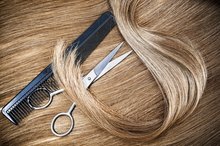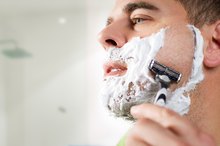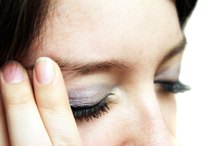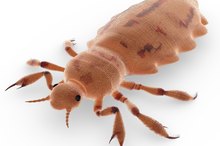What does fact checked mean?
At Healthfully, we strive to deliver objective content that is accurate and up-to-date. Our team periodically reviews articles in order to ensure content quality. The sources cited below consist of evidence from peer-reviewed journals, prominent medical organizations, academic associations, and government data.
The information contained on this site is for informational purposes only, and should not be used as a substitute for the advice of a professional health care provider. Please check with the appropriate physician regarding health questions and concerns. Although we strive to deliver accurate and up-to-date information, no guarantee to that effect is made.
How to Make Neck Hair Stop Growing
Shaving, plucking, tweezing and depilatory creams are effective but only temporary means to keep hair growth under control. According to the Food and Drug Administration (FDA) electrolysis permanently destroys hair follicles by sending an electrical current through a needle to the hair follicle 2. The current destroys the follicle, which is then removed with tweezers. Home electrolysis devices allow you to remove unsightly neck hair in the convenience of your home 2. If done correctly, you can get professional-looking results.
Preparation
Set up a table in a brightly lit area with a comfortable chair to sit in. The brighter the light, the easier it will be for you to see the hair.
Can I Repair Chemically Treated Hair Loss?
Learn More
Place the lighted magnifying mirror on the table and angle the mirror so that you can easily see your neck.
Lay out clean paper towel on the table on either side of the mirror. Place your tweezers, extra needles, saline solution, and isopropyl alcohol on the paper towel.
How to Add Olive Oil to Shampoo
Learn More
Wash your hands and neck with antibacterial soap, then clean the area you plan to treat with isopropyl alcohol.
Wipe clean the tips of the tweezers and the tip of the applicator pen with isopropyl alcohol to disinfect the tools.
- Set up a table in a brightly lit area with a comfortable chair to sit in.
- Place the lighted magnifying mirror on the table and angle the mirror so that you can easily see your neck.
Treatment
Moisten your thumb and fingers with saline solution. Take care not to let them become dripping wet.
Set the applicator pen's intensity to the lowest setting and push the slide control forward to expose the probe needle from the tip of the applicator pen.
Hold the applicator pen with your thumb and fingers on the metal band. This will complete the circuit needed to generate an electrical current.
Select the neck hair you wish to remove and note the angle that it protrudes from the skin.
Insert the needle along the underside of the hair (or the interior angle) where it meets the skin and gently push the needle into the hair follicle. Take care to apply downward pressure to prevent bending the needle.
Hold the needle in place and gently rotate the needle until you feel a tingling sensation. Gradually increase the intensity if you do not feel a tingling sensation.
Hold the needle firmly in place for 15 seconds, then remove the needle.
Use your tweezers to gently remove the neck hair.
Repeat Steps 3 through 8 if there is any resistance or if the skin lifts when you pull the hair. This indicates that the follicle was not destroyed. Do not repeat the process a third time if the hair still resists coming out. Move on to another hair.
Clean the skin with isopropyl alcohol when the treatment session is completed.
Tips
Wipe clean the tweezers after each neck hair is removed.
Do not squeeze the skin in the area you are working on. This will cause skin damage.
Replace the needle if it becomes bent or becomes ineffective.
Ask a friend to remove hair in the areas that you cannot easily see.
Wait 48 hours before attempting to remove any hairs that would not come out in the first session.
Warnings
Contact your physician immediately if you experience burns, blistering or develop an infection.
Do not use electrolysis if you have diabetes, hepatitis, skin disorders, impetigo, scleroderma, and lupus or if you have skin pigmentation problems.
Electrolysis is not recommended if you are pregnant, wear a pacemaker, take steroids, Retin-A, Accutane or glycolic acid.
- Moisten your thumb and fingers with saline solution.
- Select the neck hair you wish to remove and note the angle that it protrudes from the skin.
Related Articles
References
- FDA Consumer Updates: Removing Hair Safely
- Hair Facts: Home Electrolysis Tips
- TeensHealth from Nemours. Hair removal. Updated August 2016.
- National Organization for Rare Disorders. Trichotillomania.
- NIH MedlinePlus. Depilatory poisoning. Updated April 9. 2020.
- Michigan Medicine. Electrolysis for removing hair. Updated October 30, 2019.
- American Academy of Dermatology. Laser hair removal: FAQs.
- USFDA. Vaniqa™. Updated July 27, 2000.
- Hamzavi I, Tan E, Shapiro J, Lui H. A randomized bilateral vehicle-controlled study of eflornithine cream combined with laser treatment versus laser treatment alone for facial hirsutism in women. J Am Acad Dermatol. 2007;57(1):54-9. doi:10.1016/j.jaad.2006.09.025
- Hamzavi, I., Tan, E., Shapiro, J., Lui, H. (2007). A randomized bilateral vehicle-controlled study of eflornithine cream combined with laser treatment versus laser treatment alone for facial hirsutism in women. J Am Acad Dermatol, Jul, 57, 1, 54-9.
- Wanitphakdeedecha, R., Alster, T.S. (2008). Physical means of treating unwanted hair. Dermatol Ther, Sep-Oct, 21, 5, 392-401.
Writer Bio
Dwight Romulo Valdez, M.A., FAAA, has been writing health and technology articles since 2008. His articles have appeared on Youandmemagazine.com and Helium.com. Valdez has been in the hearing health care profession since 1983 and currently runs an audiology practice in New Hampshire.









